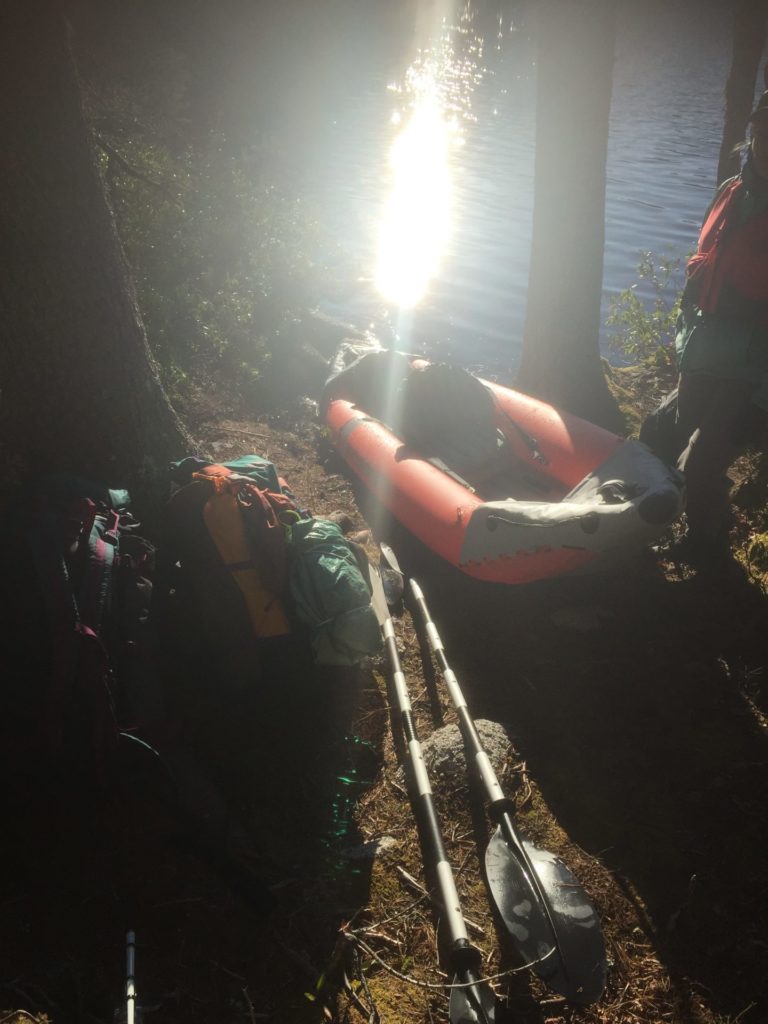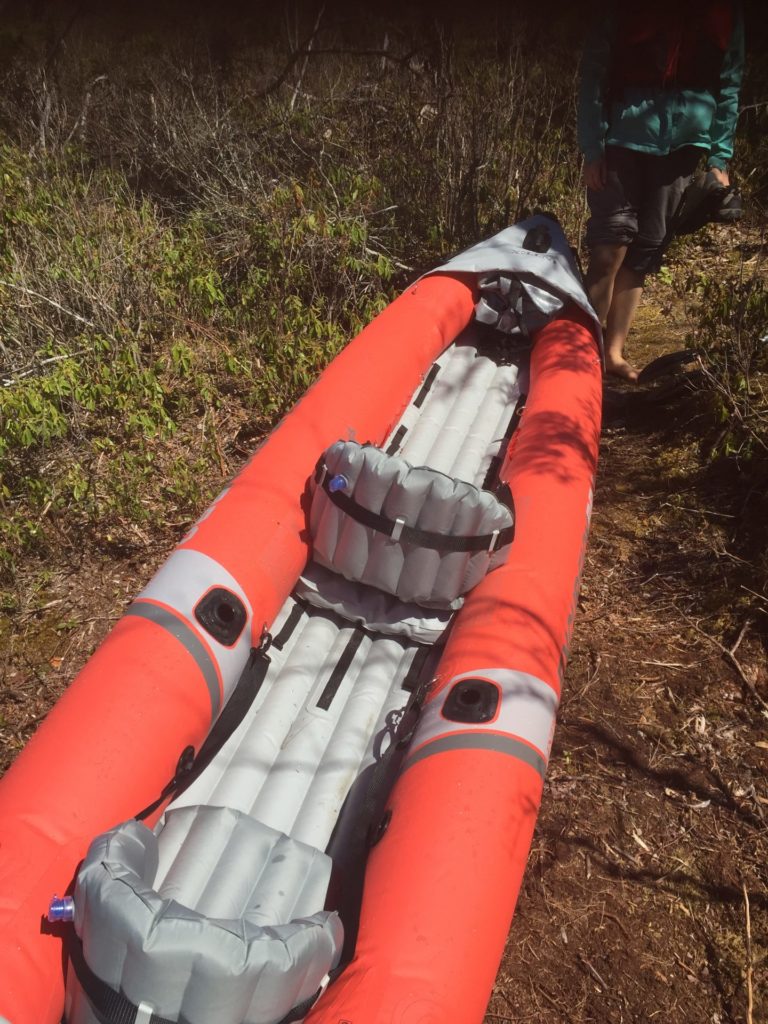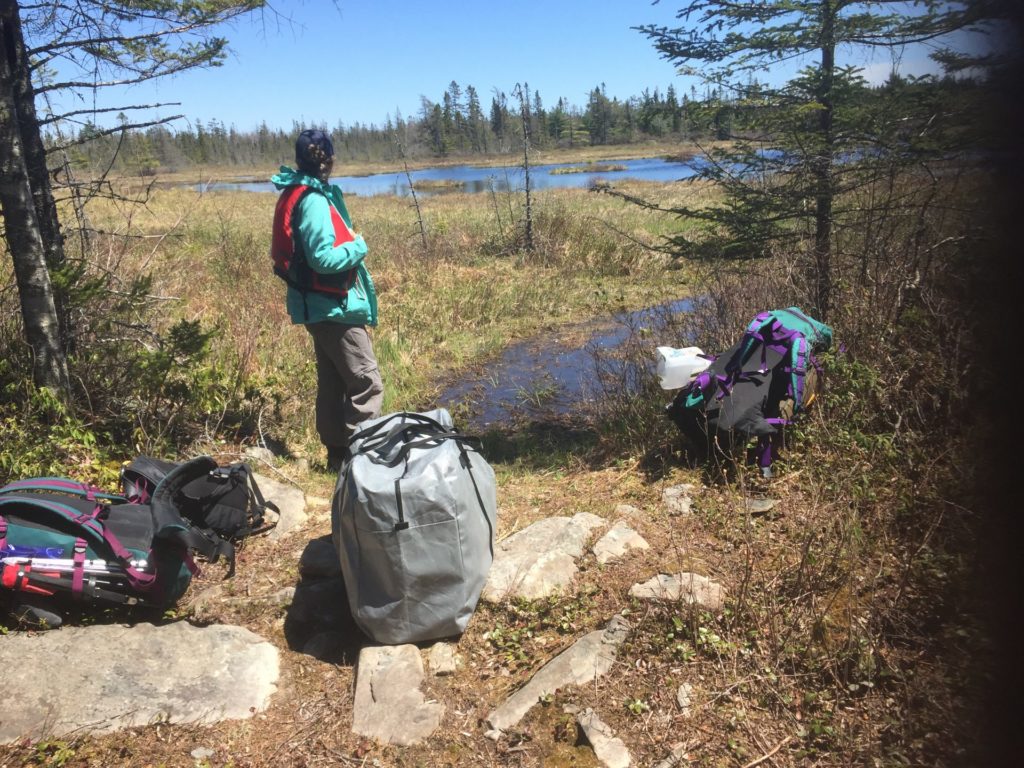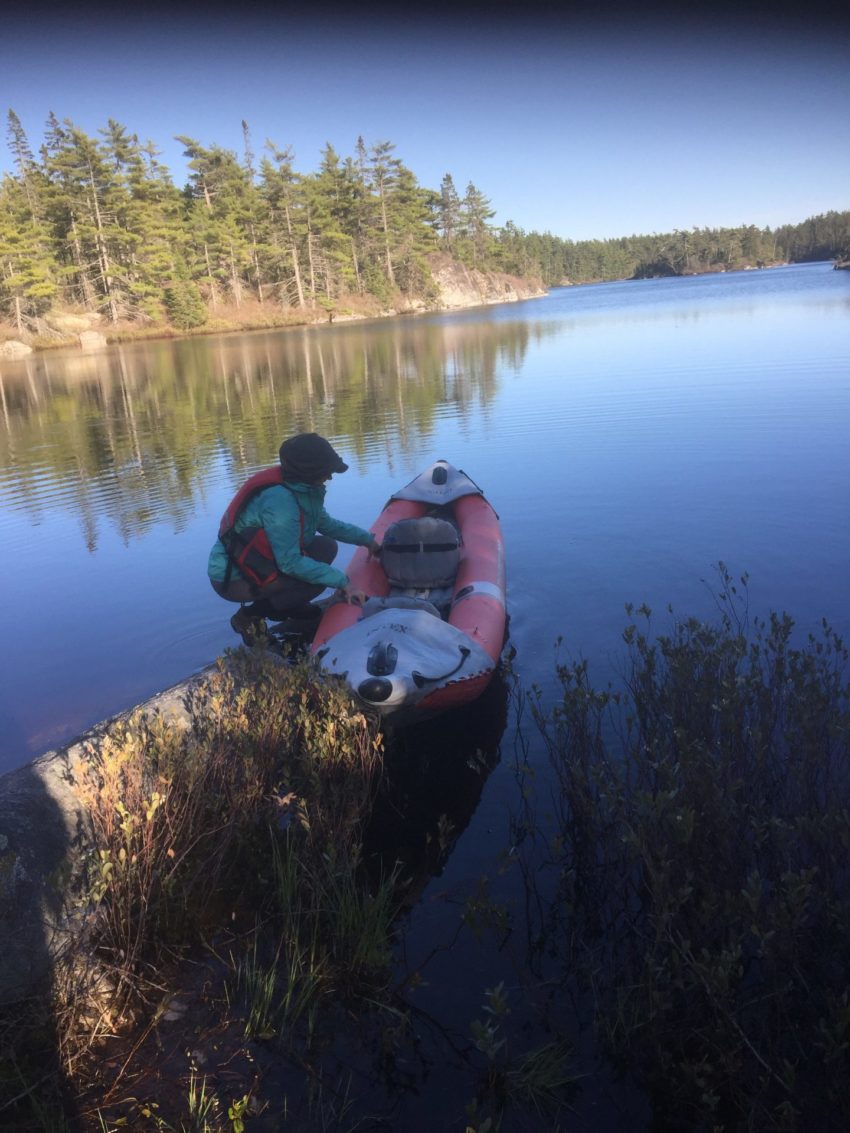I have spent years canoe camping throughout Ontario parks such as Algonquin, as well as planning numerous white water canoe trips. After getting married my wife and I moved to Nova Scotia Canada.
Nova Scotia provides numerous opportunities for Canoe and Kayak camping. Of course the obvious choice is the many ocean islands and tidal rivers that surround the province. However, there is also a lot of interior lakes and rivers to explore as well.
Our circumstances were that we lived in a very small apartment. Having a large hard bodied canoe or kayak was really out of the question due to storage limitations.
As a result I began to look at inflatable kayaks. After purchasing and using an inflatable in various paddling situations, I learned that owning an inflatable has some great pros. As we began using the kayak in local lakes and harbors I began to gain confidence that I could use it in a backwoods camping trip.
We decided to take our Intex Excursion inflatable on a 3-day backwoods camping trip. I would like to share our experience using this kayak.
Table of Contents
Kayak Build Quality

This Kayak overall was built very well for the price. The Kayak is made with 3 layers and feels quite substantial. The outer layer and inner layer are made with PVC otherwise known as vinyl. PVC is a good choice for durability, price, and workability. It can be bonded well and can handle UV rays without breaking down quickly. The inner layer is made of polyester and is a good choice for ripstop. While a nylon core is more effective at stopping tears and punctures, poly does not flex as much so inflates well making a more rigid boat.
The kit comes with kayak paddles that snap together. The paddles themselves are not as durable as a whitewater paddle however they are good enough for flat water usage.
The pump is fast. We were able to inflate the kayak and have it set up to go in about 10-15 minutes. The kayak has 3 chambers. If you did puncture the floor your kayak would still float and you would be able to paddle to safety.
The great feature that the pump has is you can reverse the airflow when you want to deflate the kayak. Instead of needing to stand or roll the kayak in an exhausting and time-consuming way to deflate, you simply reverse the flow and the pump draws all the air out of the chambers until the kayak looks vacuum sealed. This is great for stowing the kayak back in its bag.
The kayaks air valves are another great feature. There is a spring-loaded valve for each chamber. You simply attach the end of the pump tube and twist it onto the valve. After inflation you simply untwist the tube and the valve springs shut, so no air is lost.
There is a pressure gauge included so you can check your chambers to make sure they are inflated properly. There will be some air expansion and contraction depending on outside air temperature.
The kayak comes with a bow and stern deck. We used these decks for placing our packs on and securing them. The kayak is only about 13 feet long, so arranging the packs in this way freed up our legroom. It also distributed the weight evenly throughout the boat.
The decks are also useful for storage. We stored the pump assembly underneath the rear deck behind the seat. It stayed there for the duration of the trip for easy access.
The only weak link of the entire kit was the pump tube and stem. It is made out of cheap plastic. I made sure to detach the tube from the pump when storing so as to not put a kink in the tube. I will probably order a second more durable tube and stem as a backup for the next trip.
The boat comes with various tie-down locations. These are handy for strapping on packs and other things. There are also 2 inflatable seats and a booster included in the package. The seat back support was surprisingly good. You should make sure the seat backrest is positioned straight up or even slightly forward so when you lean back it provides good support.
We had to try a few seating positions until we found one that was right for us. I am 5’10 and my wife is 5’6. We were able to arrange the seats so we had adequate legroom and would not slap paddles. We found that once we had it set up right we were very comfortable.
My wife used the booster seat, and I have ordered another one since sitting up a bit higher in the boat is what we prefer.
The seats can be inflated using the pump which is very fast or you can inflate with your mouth. Inflation with your mouth is fast and easy if you want to keep the pump stowed. The seats are held in place with Velcro. We found the Velcro held the seats well and when the vessel was turned upside down for portage they stayed in place.
The kayak also comes equipped with 2 handles a front and rear for easy moving. We found the handles came in quite handy during our trip.
The kayak seams were built well and we had no issues with tears or delamination. It is a normal occurrence for an inflatable to lose a little air over the day. This varies depending on the materials used. I knew that PVC held air better than other build materials, however, I was surprised at how well. Over the 3 day trip I hardly lost any air. Only on the final day when we were departing did I decide to give it a little shot of air. It wasn’t really necessary though.
Temperatures during our trip dropped to near freezing during the night and rose to plus 17C during the day. The kayak was less firm in early morning however as the morning sun warmed, the kayak firmed up.
Included in the kit are 2 footrests. We found they just got in the way during our trip also didn’t use them. They may be good for extra paddling power around lakes where you don’t need space for storage.
Portaging the Kayak

During our excursion we had 4 large portages to make. At first I deflated the kayak for each portage, being worried that I might puncture it somehow. However on the final portage I decided to portage with the kayak inflated. It worked out great, so I kept the boat inflated for the rest of the trip.
For portages I would move the rear seat slightly back towards the stern. I deflated the rear seat and rested my head on it and the inflated booster seat. The boat itself weighed probably around 25-30Lbs making for a fairly light boat to portage as compared to a standard priced canoe. Since the boat did not have a closed deck it was able to be portaged by one person easily.
We had 4 portages. The first was 600 meters, second 872 meters, third 772 meters and the final portage was 349. The final portage into our destination lake went over very steep terrain, particularly the final portion.
On the return trip back to our vehicle we did the portages in reverse order. Because the boat was lightweight, I was able to carry all my gear at once. I don’t see how that would be possible for the very steep 349-meter portage with any canoe other than a Kevlar unless the person had unusual strength and endurance.
While the kayak rested mostly on my head and backpack (not my shoulders) the lightweight, short length and softness made it quite comfortable to portage. Actually, my pack was probably more painful than the kayak on the long portages.
Kayak Paddling And Handling
I have paddled canoes for years. I also owned a 1 person hard-shelled kayak. I must say that for an inflatable this kayak paddles well. It seems just as fast as a canoe, even a little faster since you have 2 people with kayak paddles rather than the single paddles for a canoe.
Ideally I found the paddles were a little short and contributed to getting a little bit splashed from time to time. I will possibly look for longer paddles at some point. The water splashing was very minimal though.
The kayak was very comfortable. The gunnels were not too far out to make paddling uncomfortable. The kayak comes with a large and small skeg. The large skeg worked great and the kayak was very easy to track. We used the large skeg for the majority of the trip.
We have taken this kayak out on windy days and with two people it holds well in moderate wind. With the gear loaded it is even better.
We arranged our backpacks to maximize legroom. This is only a 13-foot vessel so we needed to find a way to bring 3 days worth of camping equipment. We put the 2 packs on top of the front and back decks. We laid them width-wise and strapped them on with bungee cords. We found that placing one on the bow and one on the stern balanced the weight perfectly. After sitting in the kayak we found them to be very stable with this arrangement. We also had ample legroom.
The great feature of this kayak is its ability to switch from tandem to a single. All you need to do is move the front seat back on the Velcro strip. While my wife stayed at camp I took the kayak out fishing.
In single mode the kayak is great. You have ample legroom and lots of storage space for fishing equipment. The kayak still tracks well and is maneuverable. To keep the fish smell out of the boat (since I didn’t want to wash it off before storage in our apartment) I used a fish stringer. This way I kept the fish fresh and out of the boat.
While the deck is durable PVC you still need to be aware of any risk of puncture from fish hooks or even some species of fish. Bringing certain kinds of fish into the boat would not be recommended.
While the day I went fishing was calm, once the wind picked up it was more difficult to hold my position. I could see the advantage of using some sort of anchor in more windy conditions.
Kayak Durability
Overall I found this Kayak won both mine and my wife’s confidence. We will be bringing it on more trips in the future. On a few occasions we accidentally ran onto a submerged rock. If this was a canoe it would have left paint behind on the rock. I checked the underside of the kayak and could see a few very minor surface scratches. I think in most cases the kayak can handle this type of abuse. If you accidentally hit a sharp rock though at a good speed you could potentially risk a puncture. However, the 3 layered material seems quite durable so it would take a bit to puncture it.
Our trip was not just a trip around a lake at the cottage. This was a more rigorous excursion into a remote area. While we were careful, the kayak was inevitably abused to an extent. At portage take-outs and put-ins and portaging it through the brush it took bumps and scraps but performed well.
Kayak Value

This kayak is a great value. It is at a good price point for what you get as compared to other more expensive inflatables. While it may not be tough enough for white water, for a trip like ours it performed well.
PVC is easily repairable so if you do get a small leak it could be repaired on the go. I think this kayak will be useful for a fairly long time. I am already looking forward to our next trip. I’m glad we decided to give inflatable technology a chance. I have been pleasantly surprised.
My Conclusion
Can you go camping in an inflatable kayak? Yes definitely. You do need to choose an inflatable that has at least a moderate build quality. You also need to ensure that you bring a repair kit for any unexpected tears. That being said, an inflatable is extremely lightweight to portage, this will get you into some pretty isolated areas.
While a hard bodied vessel has its definite advantages such as speed and durability, if they are damaged they can be more difficult to repair in the field than an inflatable. The fact that an inflatable can be packed away and thrown in a closet makes the inflatable an appealing choice by many.
